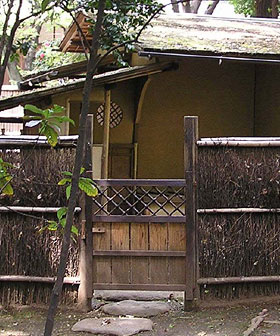|
||
 |
||
1 The generic term for a gate in a fence between 250 and the ancient periods.
2 A gate to a castle compound or an enclosure containing a warrior's mansion, particularly in the 13c-16c. The structure was simple, with two earth-fast gateposts *hottatebashira 掘立柱 on which were hung a pair of timber swing-doors, hirakitobira 開き扉 with battens *me-ita 目板 and sometimes areas of lattice work *koushi 格子.
3 In Kyoto and other towns during both the medieval and pre-modern periods, the kido was a gate similar in form to that described above 2, but set across the public thoroughfare, separating one urban district *machi 町 from another, or dividing the residential districts of different groups or social classes - eg. warriors and artisans. The gates, which often had a wicket gate *kugurido 潜り戸 set into one of the leaves, were attended by gatekeepers and were shut at night or in times of unrest.
4 A hinged door in a fence closing a vista, mikiri 見切り in a landscaped garden, often constructed of light materials such as miscanthus reed *kaya 茅. It was rustic in style.
5 Also called *kidomon 木戸門. A type of simple middle gate *chuumon 中門 often called a wicket used to divide an outer tea garden *sotoroji 外露地 from an inner tea garden *uchiroji 内露地. Two slender log posts, often of slightly different heights, are pounded into the ground and joined by a lintel. Suspended from the frame is a door with regularly spaced transverse boards mesukashido 目透戸, a braided bamboo door sunokodo 簀子戸 or garden door *shiorido 枝折戸. There is no roof. Variations include: the bolted door gate *sarudo 猿戸, and the so-called horned-door with projecting lintel *tsunodo 角戸. Kido are generally divided into the Rikyuu 利休 type, Sekishuu type *Sekishuuryuu 石州流, and dry wood gate, karekido 枯木戸. The term is found in ISHIGUMI SONOU YAEGAKIDEN 石組園生八重垣伝 (1827) by Akisato Ritou 秋里籬島.
6 An abbreviation of *nezumikido 鼠木戸, the entrance to shibaigoya 芝居小屋, and other traditional playhouses.
7 In Saitama prefecture, a gate (usually unroofed) constituting the rear entry to the plot behind an urban house *machiya 町家 during the Edo period.

5 *kidomon 木戸門 Rokusou'an 六窓庵
Tokyo National Museum (Tokyo)
Tokyo National Museum (Tokyo)
(C)2001 Japanese Architecture and Art Net Users System. No reproduction or republication without written permission.
掲載のテキスト・写真・イラストなど、全てのコンテンツの無断複製・転載を禁じます。

